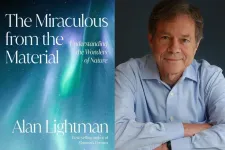(Press-News.org) CLEVELAND--University Hospitals Brain Health & Memory Center is now treating patients with KISUNLA™ (donanemab), a Food and Drug Administration-approved medication for the treatment of Alzheimer’s disease. UH is the only health system in Northeast Ohio currently offering these infusion treatments. Donanemab has shown promise in clinical trials and may be a treatment option for patients with mild cognitive impairment and mild dementia due to Alzheimer’s disease.
“People with Alzheimer’s disease have an abnormal buildup of plaques in their brain that contain a protein called beta-amyloid. Donanemab is an intravenous medication designed to target and remove these plaques,” explained Rajeet Shrestha, MD, psychiatrist, UH Neurological Institute, and assistant professor at Case Western Reserve University School of Medicine. “As the second FDA-approved treatment to address the potential underlying cause of Alzheimer’s, donanemab therapy has the potential to slow cognitive and functional decline if started in the early stages of the disease. We’re happy to be able to offer this breakthrough treatment to patients and provide them and their families with hope as we work towards a cure for this disease.”
Donanemab is administered every four weeks through IV infusion, with each infusion lasting about 30 minutes. Patients are monitored for a period of time, usually about 30 minutes, after each infusion to ensure there are no negative reactions to the drug. The number of infusions is dependent upon the patient: some may be able to stop treatment in as little as six months, while others could receive treatment for up to 12 or 18 months.
“At University Hospitals, we provide comprehensive disease management for our patients including access to the latest treatments available for Alzheimer’s disease,” said Mohamed Elkasaby, MD, neurologist, UH Neurological Institute, and Assistant Professor of Neurology at Case Western Reserve School of Medicine. “Patients with symptoms of early Alzheimer’s and the confirmed presence of beta-amyloid plaques in the brain may be eligible for treatment with donanemab. Although there is no single diagnostic test to confirm Alzheimer’s disease, physicians may use a variety of approaches to help them make a diagnosis and determine if treatment with donanemab might be appropriate.”
Early symptoms of Alzheimer’s may include mild cognitive impairment, such as forgetfulness and confusion, and mild dementia, where people have difficulty performing familiar tasks. To confirm eligibility, tests and procedures for patients may include:
Comprehensive personal and family medical history
Mental status tests
Physical and neurological exams
Blood tests
Spinal tap to remove a sample of cerebrospinal fluid for testing
MRI of the brain
PET scan of the brain to look for the presence of beta-amyloid plaques
Donanemab can have side effects, some of which are serious. Patients approved to receive donanemab therapy will be carefully monitored at set intervals as determined by their physician. Subsequent brain MRI’s, EKG’s, and lab tests will be obtained periodically to monitor for ARIA and other serious side effects of treatment.
For more information on the donanemab infusion program, and to learn more about eligibility requirements and potential side effects, call Rebecca DiFranco, RN, Alzheimer's Disease Care Coordinator, UH Brain Health and Memory Center, at 216-464-6203, or visit: https://www.uhhospitals.org/services/neurology-and-neurosurgery-services/conditions-and-treatments/brain-health-and-memory/donanemab-for-alzheimers
UH is also proud to offer an additional FDA-approved treatment option for Alzheimer’s. For more information about LEQEMBI® (lecanemab), visit: https://www.uhhospitals.org/services/neurology-and-neurosurgery-services/conditions-and-treatments/brain-health-and-memory/lecanemab-for-alzheimers
Dr. Elkasaby will discuss both treatment options via a virtual health talk on January 22, 2025. Registration information will be posted, and patients can access additional health talks from UH experts on this site: https://www.uhhospitals.org/health-talks
###
About University Hospitals / Cleveland, Ohio
Founded in 1866, University Hospitals serves the needs of patients through an integrated network of more than 20 hospitals (including five joint ventures), more than 50 health centers and outpatient facilities, and over 200 physician offices in 16 counties throughout northern Ohio. The system’s flagship quaternary care, academic medical center, University Hospitals Cleveland Medical Center, is affiliated with Case Western Reserve University School of Medicine, Northeast Ohio Medical University, Oxford University, Taiwan National University College of Medicine and the Technion Israel Institute of Technology. The main campus also includes the UH Rainbow Babies & Children's Hospital, ranked among the top children’s hospitals in the nation; UH MacDonald Women's Hospital, Ohio's only hospital for women; and UH Seidman Cancer Center, part of the NCI-designated Case Comprehensive Cancer Center. UH is home to some of the most prestigious clinical and research programs in the nation, with more than 3,000 active clinical trials and research studies underway. UH Cleveland Medical Center is perennially among the highest performers in national ranking surveys, including “America’s Best Hospitals” from U.S. News & World Report. UH is also home to 19 Clinical Care Delivery and Research Institutes. UH is one of the largest employers in Northeast Ohio with more than 30,000 employees. Follow UH on LinkedIn, Facebook and Twitter. For more information, visit UHhospitals.org.
END
Asking children “What does a scientist look like?” now results in more illustrations of women and people of color than decades ago. But do generative artificial intelligence (AI) tools also depict the diversity among scientists? Researchers reporting in the Journal of Chemical Education prompted AI image generators for portraits of chemists. They found that none of the collections accurately represents the gender, racial or disability diversity among real chemists today.
Millions of images are being created by generative AI each day. And the output of these tools is only as good as their algorithms and the initial images used to train ...
When we gaze at nature’s remarkable phenomena, we might feel a mix of awe, curiosity, and determination to understand what we are looking at. That is certainly a common response for MIT’s Alan Lightman, a trained physicist and prolific author of books about physics, science, and our understanding of the world around us.
“One of my favorite quotes from Einstein is to the effect that the most beautiful experience we can have is the mysterious,” Lightman says. “It’s the fundamental emotion that is the cradle of true art and true science.”
Lightman explores those concepts in his latest book, “The ...
Today, Nature and other Nature Portfolio journals published a collection of more than 40 peer-reviewed papers marking a milestone toward researchers’ understanding of the human body in health and disease and the development of the first draft of the Human Cell Atlas (HCA). The Human Cell Atlas is an international community whose mission is to align groups engaged in creating comprehensive reference maps of all human cells — the fundamental units of life — as a basis for understanding human health and for diagnosing, monitoring, and treating disease. The Chan Zuckerberg Initiative (CZI) is one ...
Rivers and streams serve as critical connectors across vast geographical landscapes, trickling out of tucked-away headwaters and snaking thousands of miles toward oceans and deep seas. These waterways directly impact human and environmental health, agriculture and energy production, and supply the United States with two-thirds of its drinking water. And yet, compared with other larger waterbodies, the microbiology of rivers is relatively understudied.
A Colorado State University-led team of scientists have contributed to changing that — detailing for the first time both broad and specific information ...
The most comprehensive cell map of the human gut to date has been created by combining spatial and single-cell data from 1.6 million cells.
Mapping the cells of the gut can provide us with further insights into what happens in conditions such as bowel cancer and Inflammatory Bowel Disease (IBD). Using this atlas, researchers from the Wellcome Sanger Institute and collaborators uncovered a new role of a specific gut cell, highlighting its contributions to a cycle of inflammation in some individuals, possibly causing pain and distress.
The study, published today (20 November) in Nature, details how the team ...
Researchers at Karolinska Institutet have found a molecule that can both help the intestines to heal after damage and suppress tumour growth in colorectal cancer. The discovery could lead to new treatments for inflammatory bowel disease (IBD) and cancer. The results are published in the journal Nature.
Many patients with inflammatory bowel disease (IBD) such as Crohn’s disease or ulcerative colitis do not respond to available treatments, highlighting the need to identify novel therapeutic strategies. In a new study published in Nature, researchers propose that promoting ...
About The Study: In this cross-sectional study, postpartum depression (PPD) diagnosis increased significantly across all racial and ethnic groups and body mass index (BMI) categories over the past decade. While rising PPD may reflect improved screening and diagnosis practices, the persistently high rates highlight the need to develop and implement interventions to prevent the condition while expanding efforts to mitigate the impact of PPD on maternal and child health.
Corresponding Author: To contact the corresponding author, Darios Getahun, MD, PhD, ...
About The Study: The findings of this population-based matched cohort study suggest that individuals born preterm were at an increased risk of death from birth until their third and fourth decades of life, with higher risks as gestational age decreased. Some of these associations may have been partly due to underlying health determinants that affected preterm birth and mortality. These findings suggest that preterm birth should be recognized as a risk factor for mortality and could inform preventive strategies.
Corresponding Author: To contact the corresponding author, Asma M. Ahmed, PhD, MD, MPH, email asahmed@wakehealth.edu.
To access ...
New Haven, Conn. — Wings may be the obvious choice when studying the connection between dinosaurs and birds, but a pair of Yale paleontologists prefer drumsticks. That part of the leg, they say, is where fibular reduction among some dinosaurs tens of millions of years ago helped make it possible for peacocks to strut, penguins to waddle, and turkeys to trot.
“A good way to understand this is to take a look at drumsticks, like the ones people eat on Thanksgiving,” said Armita Manafzadeh, lead author ...
LA JOLLA (November 20, 2024)—More than 3 billion years ago, on an Earth entirely covered with water, photosynthesis first evolved in little ancient bacteria. In the following many millions of years, those bacteria evolved into plants, optimizing themselves along the way for various environmental changes. This evolution was punctuated around 30 million years ago with the emergence of a newer, better way to photosynthesize. While plants like rice continued using an old form of photosynthesis known as C3, others like corn and sorghum developed a newer and more efficient version called C4.
There are now more than 8,000 different C4 plant ...




